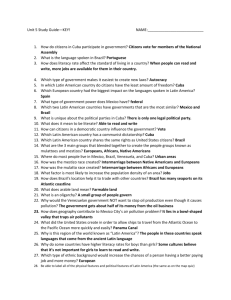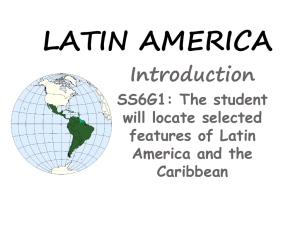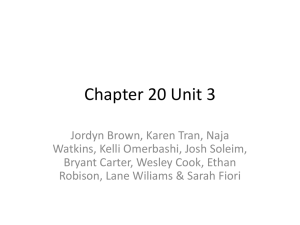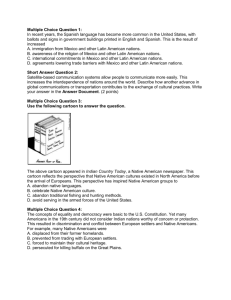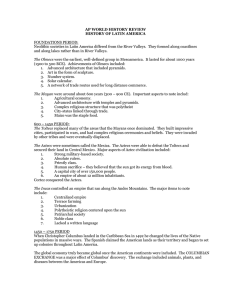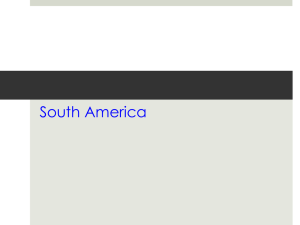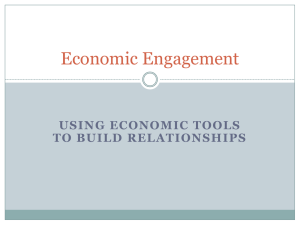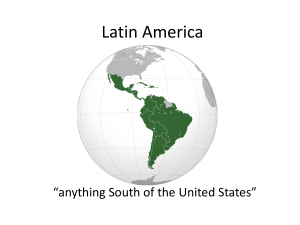AP WORLD HISTORY REVIEW HISTORY OF LATIN AMERICA
advertisement
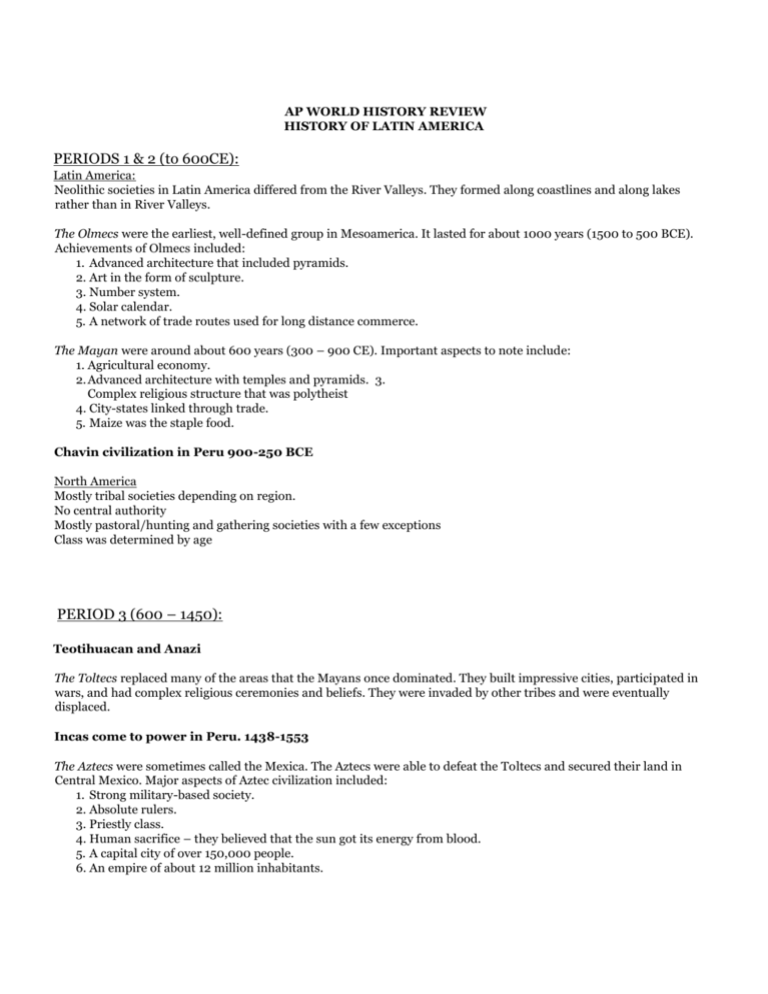
AP WORLD HISTORY REVIEW HISTORY OF LATIN AMERICA PERIODS 1 & 2 (to 600CE): Latin America: Neolithic societies in Latin America differed from the River Valleys. They formed along coastlines and along lakes rather than in River Valleys. The Olmecs were the earliest, well-defined group in Mesoamerica. It lasted for about 1000 years (1500 to 500 BCE). Achievements of Olmecs included: 1. Advanced architecture that included pyramids. 2. Art in the form of sculpture. 3. Number system. 4. Solar calendar. 5. A network of trade routes used for long distance commerce. The Mayan were around about 600 years (300 – 900 CE). Important aspects to note include: 1. Agricultural economy. 2. Advanced architecture with temples and pyramids. 3. Complex religious structure that was polytheist 4. City-states linked through trade. 5. Maize was the staple food. Chavin civilization in Peru 900-250 BCE North America Mostly tribal societies depending on region. No central authority Mostly pastoral/hunting and gathering societies with a few exceptions Class was determined by age PERIOD 3 (600 – 1450): Teotihuacan and Anazi The Toltecs replaced many of the areas that the Mayans once dominated. They built impressive cities, participated in wars, and had complex religious ceremonies and beliefs. They were invaded by other tribes and were eventually displaced. Incas come to power in Peru. 1438-1553 The Aztecs were sometimes called the Mexica. The Aztecs were able to defeat the Toltecs and secured their land in Central Mexico. Major aspects of Aztec civilization included: 1. Strong military-based society. 2. Absolute rulers. 3. Priestly class. 4. Human sacrifice – they believed that the sun got its energy from blood. 5. A capital city of over 150,000 people. 6. An empire of about 12 million inhabitants. Cortez conquered the Aztecs. The Incas controlled an empire that ran along the Andes Mountains. The major items to note include: 1. Centralized empire 2. Terrace farming 3. Urbanization 4. Polytheistic religion centered upon the sun 5. Patriarchal society 6. Noble class 7. Lacked a written language North America: No major changes PERIOD 4 (1450 – 1750): Christopher Columbus landed in the Caribbean Sea in 1492 he changed the lives of the Native populations in massive ways. The Spanish claimed the American lands as their territory and began to set up colonies throughout Latin America. COLUMBIAN EXCHANGE What was exchanged between the old and new world Effects on both the old and new world The effects of new diseases on native cultures. Plantations Economies Encomienda System Mita System Dela Casas, De la Casas, a priest, suggested that the Spanish import slaves from Africa since they did not die from European diseases. The largest number of slaves from Africa was sent to Latin America. Tthe Spanish began mining for gold and silver (Mexico and Peru). The amount of silver mined from Spain was so great that the final of silver in Europe declined. Native Americans worked in mines until African slaves began to replace them. Mines were owned privately, but they had to send 20% to the Spanish government. the Line of Demarcation (Treaty of Tordesillas). There was great competition between Brazil and the Caribbean in the sugar market. To ensure that there were enough slaves for Brazil, Portugal outlawed slavery within the country of Portugal. Brazil became the world’s main source of sugar around 1600. West Indies were the world’s main source of sugar by 1700. SOCIAL AND GOVERNMENTAL SYSTEM The Viceroys ruled the Spanish colonies. The multi-ethnicity of Latin America was the most diverse in the world. First social structure did exist that greatly limited some people. The system that emerged was: • Peninsulares – those born in Europe • Creoles – those born in the Americas, but to European parents; the lack of status and rights for this group led to dissent and eventual rebellion • Mestizoes and other mixed race individuals were at the bottom of the structure. • Women did have rights in dowry, inheritance, and some access to commerce. North America British and French colonies 1607-1640 Only men allowed to vote Columbian Exchange brought new animals and crops. African Slave Trade and how it was different from Latin America? Colonial US Influence of Enlightenment ideals and John Locke Colonies mostly fragmented: no central authority British take New Netherland from the Dutch in 1664. 1754-1763 French and Indian War PERIOD 5 (1750 – 1900): Revolutionary ideas from the United States and Europe inspired a wave of revolutions across Latin America. Two early but unsuccessful revolts occurred in 1781 in New Granada (The Comunero Revolt) and it Peru (led by Tupac Amaru). Racial divisions between the rebels proved to be their major downfall. Revolutions and Independence: Haiti 1791 (Toussnt-Louverture), Venezuela and Columbia 1820 (Simon Bolivar), Brazil 1822, Mexico 182 Other Major Events During This Time: • Latin America began to outlaw slavery; Brazil was the last in 1888 • Catholic Church remained the dominant influence in LA • Creoles enjoyed voting rights but Natives, Mestizoes, blacks, and women did not • Governments were mainly unstable with dictators becoming the norm (included the “enlightened” Bolivar); most were wealthy landowners • Caudillos – regional military figures – dominated many areas and normally appealed to the poor • Spain remained in Cuba and Puerto Rico until the Spanish American War • Large numbers of European immigrants continued to move to Brazil and Argentina while Mexico and Central America’s immigration era ended Latin American Economies Political Movements Mexico still had major problems with land distribution and the lack of rights for Natives. This led to an appeal for strong military leadership. This included Santa Anna who lost power because of international issues (Texas Revolution and Mexican Ame9rican War. The landowners sought help from France who overthrow the republic and placed the Austrian Habsburg Maximillian on the throne as emperor. When France left Mexico, Maximillian was overthrown and Benito Juarez ruled Mexico until 1872. Universal male suffrage was given. Landowners opposed reforms. Mexican Revolution – 1911 – 1920 Latin America continued to be defined by ethnic issues. Argentine Gauchos (cowboys) brought some rights to fellow mestizos and castizos. Male dominated society that did not allow for women suffrage movements or female education. United States Independence 1776, 1789 Checks and Balances Classes are based on race Suffrage only to males. Large middle class develops Grew into into one of the top five trading empires. 1803 Louisiana Purchase. Imperialism in the Pacific and Latin America Monroe Doctrine Philipines, Puerto Rico 1830: Women’s Reform 1848: The Seneca Falls Convention Industrial Revolution Technological innovations that spurred industrialization Large influx of immigrants from other countries 1861-1865 The America Civil War 1867 The Creation of the Dominion of Canada 1898: The Spanish American War PERIOD 6 (1900 – Present): Latin America Major events and trends: • Mexican redistribution of land • Mexico dominated by PRI (Institutional Revolutionary Party) • Argentina military rule (Peronistas) • Mixture of free elections and military dictators • Cold War led to increased U.S. involvement in Central America o U.S. helped overthrew socialists and communists learning governments in Guatemala and Nicaragua o Anti-Cuban policies and events included the overthrow of Batista in 1959 Cuba becoming a communist country under Castro. U.S. placed embargos on Cuba, organized Bay of Pigs, and confronted the Soviet Union over missiles in Cuba (closest the U.S. ever came to nuclear warfare) Latin America remains a region that is economically and politically challenged. Democracy and capitalism is expanding in many areas. Cuban Revolution (Fidel Castro) United States United States’ desire for a Panama Canal to increase trade led to support for Colombian rebels who declared an independent Panama and allowed the U.S. to build the canal in 1914. America’s role in WW1 (1917) The Great Depression United Nations formed and located in the United States The Rise of the Cold War Korean War, Vietnam, The Bay of Pigs Invasion, Cuban Missile Crisis.
